Getting Started with the Oryx 10GigE Camera
Preparing for use
Before you use your camera, we recommend that you are aware of the following resources available from the Oryx 10GigE page:
- Getting Started Manual for the camera—provides information on installing components and software needed to run the camera.
- Technical Reference for the camera—provides information on the camera’s specifications, features and operations, as well as imaging and acquisition controls.
- Firmware updates—ensure you are using the most up-to-date firmware for the camera to take advantage of improvements and fixes.
- Tech Insights—Subscribe to our monthly email updates containing information on new knowledge base articles, new firmware and software releases, and Product Change Notices (PCN).
System Configuration
Note: Testing is ongoing. This document will be updated as new results are found.
We successfully tested two Oryx 10GigE cameras simultaneously on the following system:
| COMPONENT | DESCRIPTION |
| Motherboard | AIMB-786G2-00A1 |
| Chipset | 96MPI7C-3.2-12M11T Intel(R) Core(TM) i7-8700 CPU @ 3.20GHz |
| Memory | 2 x 8G DDR4-2666 1GbX8 1.2V SAM |
| Hard Drive | SG AV 4TB 3.5"" 5KRPM SATAIII 64MB |
| Network Adapter | FLIR ACC-01-1107 Network adapters were installed in PCIe16_x1 and PCIe16_x2 slots. Do not use a PCIe slot that shares resources. |
| Cable | FLIR ACC-01-2101 4.5 meter, RJ45 to RJ45, Cat5e |
| Power Supply | IPC-7132MB-40ZE |
| Operating System | Windows 7 x64 |
| SDK | Spinnaker 3.0 |
| Driver | Point Grey Lightweight Filter Driver 2.7.3.586 |
| Camera | ORX-10G-123S6C and ORX-10G-123S6M |
| Firmware | 1610.1.264.0 |
Note: for optimal driver performance, we recommend using Spinnaker 4.0 or later.
Oryx Configuration
To get your Oryx camera running, complete the following steps:
Step 1—Install interface card
Step 2—Install Spinnaker SDK
Step 3—Verify and update firmware (if necessary)
Step 4—Verify and update camera driver (if necessary)
Step 5—Optimize stream parameters
Step 1—Install interface card
Check your computer's motherboard specifications to determine which slot to place the network interface card (NIC). Usually, the slot for video cards works well but you may need to check the motherboard's bios to get the optimal slot to run with and update the bios settings to run at faster rates.
Note: Avoid any slots that share resources.
You may also need to update to the latest driver depending on the NIC you are using.
Network cards that we have tested include:
- ACC-01-1107: 10GBASE-T Ethernet PCI Express 3.0 x4 Dual Port Adapter, Intel X550AT2
- ACC-01-1106: 10GBASE-T Ethernet PCI Express 2.1 x4 Single Port Adapter, AQC107
If Windows does not recognize the card, you may have to install the manufacturer's driver on the device.
In most cases, the default settings for the card do not need to be changed. However you should verify the following settings:
- Jumbo Packets—Set to maximum supported (9014 bytes)
- Receive Buffers—Set to maximum supported (4096)
- Receive Slide Scaling—Set to enabled
- Offloading Options—Set to UDP Checksum Offload and set value to RX and TX enabled
- Internet Protocol—Set to TCP/IPv4
To verify the interface card settings:
1. In Windows, open the Control Panel to Network settings.
2. Right click the network adapter and select Properties.

Step 2—Install Spinnaker SDK
Spinnaker SDK is the API used for device control and image acquisition. For optimal performance, use Spinnaker version 4.0 or above.
1. Download the SDK from our Downloads page.
2. Launch the install wizard and follow the installation instructions.
3. For Installation Profile, choose one of the following options and click Next:
- Camera Evaluation—to install SpinView and related documents only. This includes the camera drivers.
- Application Development—to install the full SDK, SpinView, and related documents.
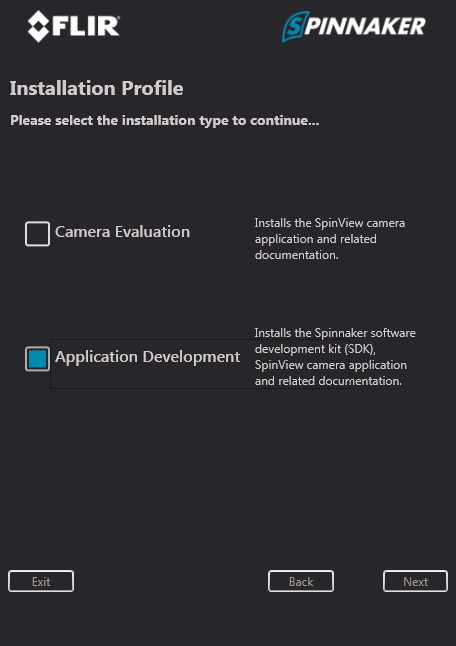
4. For Installation Components, items are selected based on your profile. If not already selected, select GigE Driver to work with 10 GigE cameras.
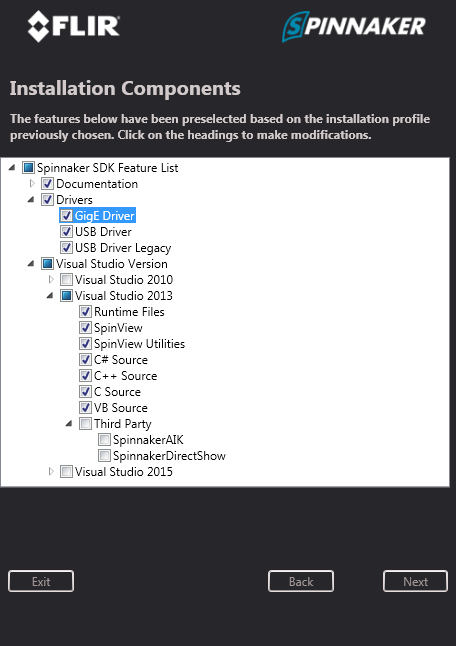
5. Click Next and complete the installation.
Step 3—Verify and update camera firmware
The latest firmware can be found from our Oryx support page. Use firmware version 1610.1.213.0 or above.
SpinView can be used to verify and update camera firmware.
1. Download firmware file from our Downloads page.
2. Launch SpinView:
Start-->Teledyne-->Spinnaker SDK-->SpinView
3. Right-click on the camera and select Update Device Firmware.
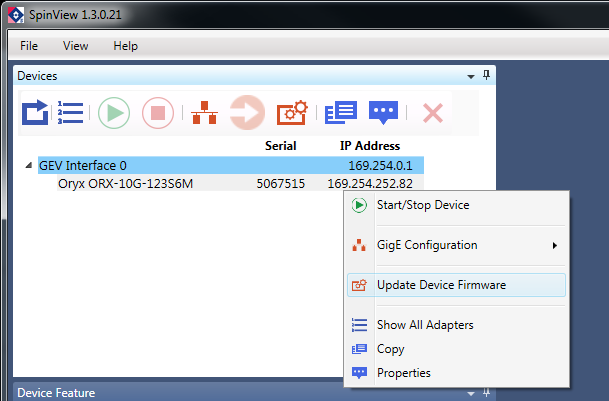
4. Click Browse and navigate to downloaded firmware file.
5. Select the file and click Open.
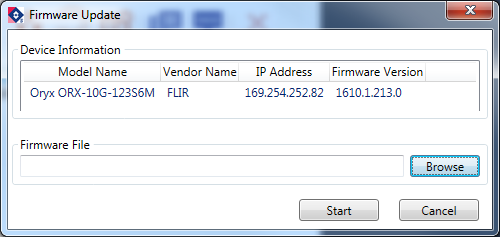
6. Click Start.
Warning! Do not disconnect the camera until the firmware update is complete.
Step 4—Verify and update driver
The driver is installed automatically by the Spinnaker SDK installer for Camera Evaluation or for Application Development if the Drivers checkbox is selected (default). A restart may be required.
For optimal driver performance, install Spinnaker version 4.0 or later.
Alternatively, you can manually install the driver. The driver files are located in:
C:\Program Files\Teledyne\GigE Vision Interface\x64
To verify your driver:
1. Launch SpinView:
Start-->Teledyne-->Spinnaker SDK-->SpinView
2. Select the camera.
3. In the Feature tree search box, enter "driver". The Device Driver Version feature is highlighted.

4. If you need to update the driver, right-click on the camera and select Filter Driver Configuration.
5. In the Filter Driver Configuration window, ensure the driver is installed and enabled. Click Refresh if making changes.
Note: If the filter driver is not installed, a caution icon appears next to the device. Right-click on the driver and select GigE Filter driver is not installed-->Install filter driver to resolve.
Step 5—Optimize stream parameters
The SpinView application can be used to configure the stream buffer, packet size, and device link throughput values for the camera.
To adjust the stream buffer:
1. With the camera plugged in, open SpinView.
2. In the Feature panel, expand Stream Parameters, then expand Buffer Handling Control.
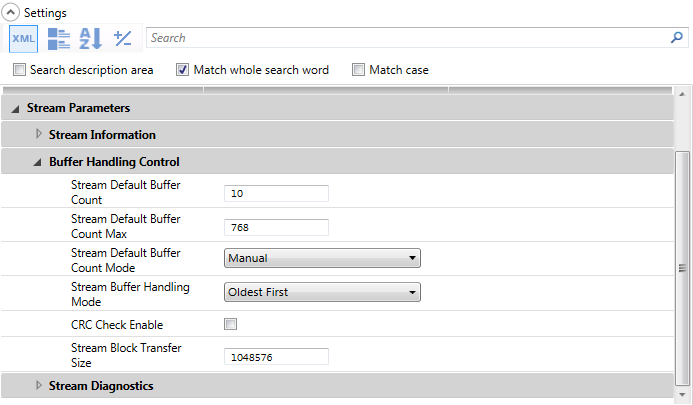

3. By default, the Stream Buffer Handling Mode is set to Newest Only and Stream Default Buffer Count is set to 10. Change the Stream Buffer Handling Mode to Oldest First and Buffer Count to a larger value suitable to your system. We recommend testing with a Stream Default Buffer Count to 50 and adjust as necessary.
Note: Increasing the Stream Default Buffer Count increases the memory usage. If your memory usage gets too high, reduce the Stream Default Buffer Count until you can stream without errors using the lowest amount of memory.
To adjust the packet size:
1. With the camera plugged in, open SpinView.
2. In the Feature pane search box enter "packet".
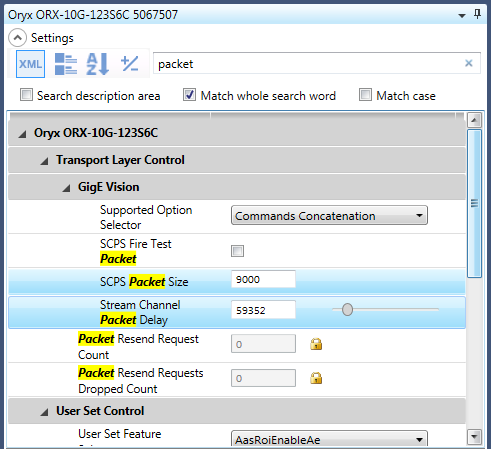
3. For the SCPS Packet Size node, enter a value less than the Jumbo packets supported by the network adapter (i.e., less than 9014).
To adjust the device link throughput:
1. With the camera plugged in, open SpinView.
2. In the Feature pane search box enter "device link".
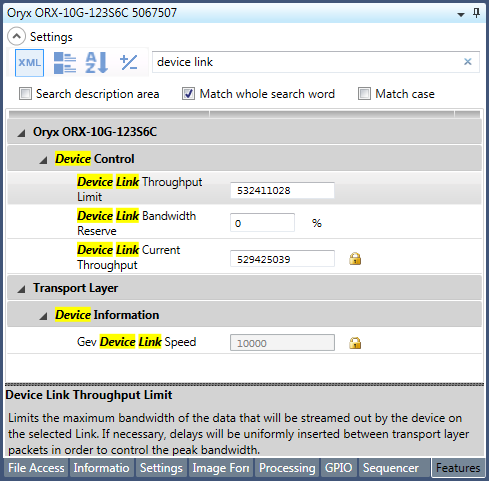
3. For the Device Link Throughput Limit node, adjust the value.
Decreasing the Device Link Throughput Limit increases the packet delay and decreases the frame rate. This reduces the possibility of dropped frames. This value can be adjusted to find the maximum frame rate with no dropped frames.
Troubleshooting tools
Camera Status LED
| No Light | No power or LED is in inactive state or LED is in error status state with no error |
| Blinking Green (1 blink) | Persistent IP Address |
| Blinking Green (2 blinks) | DHCP IP Address |
| Blinking Green (3 blinks) | Link-Local Address (LLA) |
| Solid Green | Acquisition Started |
| Rapid Flashing Green | Firmware update in progress |
| Flashing Green and Red | General Error |
Network Status LEDs
| No Light | No network connection |
| Left and Right Bright Green | 10 GigE connection |
| Left Dim and Right Bright Green | 1 GigE connection |
| Left and/or Right Blinking Green | Data transfer in progress |
Stream Diagnostics
Spinnaker provides diagnostic parameters to monitor the stream statistics.
| Display Name | TL Stream Node Name | Definition |
|---|---|---|
| Packets Recieved | GevTotalPacketCount | The number of packets received on this stream |
| Packets Missed | GevFailedPacketCount | The number of packets missed on this stream |
| Retransmitted Packets | GevResendPacketCount | The number of packets received after retransmit request on this stream |
| Failed Buffer Count | StreamFailedBufferCount | The number of images with missing leader or trailer information |
| Buffer Underrun Count | BufferUnderrunCount | The number of dropped images caused by driver running out of buffers |
| Retransmitted Packets Requested | GevResendPacketcount | The number of packets received after retransmit request on this stream |
CPU versus GPU rendering
If using an onboard graphics card, you may achieve better performance with the CPU rendering method in SpinView rather than GPU rendering. This can be changed from the View menu in SpinView.
Image Status
It is possible to get image incomplete errors when packet loss is observed. In Spinnaker, during image acquisition, you can check if the image is complete and see the status of the image.
For example:
ImagePtr pResultImage = pCam->GetNextImage();
if (pResultImage->IsIncomplete())
{
cout << "Image incomplete with image status " << pResultImage->GetImageStatus() << endl << endl;
}
| Image Status | Description |
|---|---|
| IMAGE_NO_ERROR | Image is returned without errors |
| IMAGE_CRC_CHECK_FAILED | Image failed CRC check |
| IMAGE_DATA_OVERFLOW | Received more data than the size of the image |
| IMAGE_MISSING_PACKETS | Image has missing packets |
| IMAGE_LEADER_BUFFER_SIZE_INCONSISTENT | Image leader is incomplete |
| IMAGE_TRAILER_BUFFER_SIZE_INSCONSISTENT | Image trailer is incomplete |
| IMAGE-PACKETID_INCONSISTENT | Image has an inconsistent packet ID |
| IMAGE_MISSING_LEADER | Image leader is missing |
| IMAGE_MISSING_TRAILER | Image trailer is missing |
| IMAGE_DATA_INCOMPLETE | Image data is incomplete |
| IMAGE_INFO_INCONSISTENT | Image info is corrupted |
| IMAGE_CHUNK_DATA_INVALID | Image chunk data is invalid |
| IMAGE_UNKNOWN_ERROR | Image has an unknown error |
Skipped frames
Depending on the image size and the camera's frame rate, frames may be skipped due to the driver running out of buffers because Spinnaker is not requeuing the images fast enough. A workaround is to increase the number of image buffers that Spinnaker uses (the default is 10). For example, you can set the StreamDefaultBufferCount to 100 by setting the following line before beginning acquisition:
pCamPtr->TLStream.StreamDefaultBufferCount.SetValue(100)
Troubleshooting checklist
The following suggestions may help you troubleshoot issues with your 10GigE camera:
- Update the driver to the latest version.
- Update the firmware to the latest version.
- Update the Spinnaker® SDK to the latest version. For optimal performance, we recommend Spinnaker 4.0 or above.
- Perform a soft reboot and, if necessary, a hard reboot of the PC.
- Disable and then enable the driver.
- Power cycle the camera.
- Use a separate network adapter instead of an integrated one, if available.
- Use a certified cable.
- Use a different host controller or PC.
